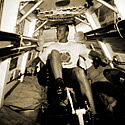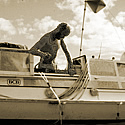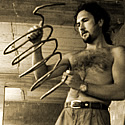 |
>>
5 a.m. WAKEY WAKEY STEVE - It's
your turn to pedal!!
With
space for only one person in the sleeping compartment we have
to take it in turns. Each person should in theory get 2 x
3hr sleep periods in any one 24hr period, but this normally
amounts to only 4 or 5 total. Long term fatigue results after
several weeks of this regime.
|
 |
 |
>>
6.30 a.m. BREAKFAST usually consists
of porridge oats (oatmeal), topped with dried fruit and/or
jam to sweeten.
Across
the Atlantic we each had a British Army arctic ration pack
every 24hrs, supplemented with 4,000
MARS BARS donated by Mars UK!
Each
pack contains upwards of 7,000 calories.
|
 |
 |
>>
THE PEDAL ROTA is continous, around
the clock, 7-days a week until we reach the other side of
the ocean.
In
the day a typical shift will last 4hrs. At night, due to the
difficulty of staying awake in darkness, a shift will last
more like 3hrs. Liken it to a hamster on a treadmill!
|
 |
 |
>>
A HOT SWEATY PEDAL SEAT awaits
the next pedaler. Being comfortable with each other's hygiene
becomes quite essential.
In
addition to the single sleeping compartment, the main reason
for having someone pedaling all the time is having a set of
eyes permanently scanning the horizon for ships. A cargo ship
traveling at 30+ knots could RUN
US DOWN in less than 25 mins >>
|
 |
 |
>>
NAVIGATION is one of the chores
to be done after breakfast. The person on break will use the
Magellan GPS to find a latitude/longitude fix which he/she
plots on a marine chart.
This
is how we know how far we've come since the last 24hr fix,
and whether we need to alter our COMPASS
'HEADING' to keep on track >>
|
 |
 |
>>
SERVICING THE PEDAL UNIT with grease
is usually a daily practice in order to ensue that the bearings
of the bottom bracket are well lubricated.
And
getting a WEATHER FORECAST
via the shortwave radio is good to know in case we need to
prepare the boat for an approaching storm >>
|
 |
 |
>>
MAKING DRINKING WATER is perhaps
the most important task of each day. Moksha's streamlined
design means she can only carrry 20 gallons of emergency water,
enough to last us just 10 days. Desalinator
pump operation.
This
is an emergency backup DISTILLATION
DEVICE (homemade): steam from boiling
seawater is condensed into drinkable water on the inside of
this copper tube, itself cooled by immersion in a bucket of
cold seawater >>
|
 |
 |
>>
12.00 p.m. LUNCHTIME is served
on the fly: usually a mug of soup accompanied by dried biscuits
(wannabe croutons), energy bar and, if early on in the trip,
an apple or orange.
COOKING
is done on a homemade stove comprising a Camping Gaz Bleuet
gas burner hanging from a rear parcel shelf taken from an
old bicycle frame; one of the arms is bent over to keep pots
and pans from sliding off >>
|
 |
 |
>>
FISHING helps lighten up what can
otherwise be a monotonous day. Our secret weapon is 'Lolita
the Lure', a regular marlin lure daubed with a rakish splash
of eyeliner - irrestible to the dorado fish that follow the
boat!
This
50lb DORADO FISH
caught with a handline was so huge we had to use a sailbag
to land it >>
|
 |
 |
>>
DOCUMENTATION of the voyage in
the form of daily written reports sent back via satellite
to the website and filming with a video camcorder for the
TV documentary series is one of the key chores for the day.
It
sometimes takes a concerted effort to have to think of a new
update or sit on the bow in front of the VIDEO
CAMERA, but recording the story
as it unfolds helps keep track of small details that might
otherwise easily be lost >>
|
 |
 |
>>
RECREATION time is usually short
due to all the other things that need to be done in the average
day: often we only have 15-20 minutes to relax.
READING helps to escape from the
world of never ending shifting blue and, after a month at
sea, WRITING
in our journals becomes a necessary cathartic outlet for our
overactive minds that churn out a mass of thought processes
to compensate for the absence of external sensory stimuli
>>
|
 |
 |
>>
PLAYING A MUSICAL INSTRUMENT -
something small like a harmonica - is a good way to break
the 'mental funk' and annoy the hell out of your pedaling
partner.
And you never know, you might even serenade a FLYING
FISH to jump on board! >>
|
 |
 |
>>
SWIMMING provides a good way to
way to cool down after a hot, sweaty pedal shift as well as
a way to get away from the boat for a few minutes each day
- the equivalent of getting out of the house and going for
a walk!
But
perhaps the best way to relax is to sit on the deck in the
early evening with a CUP of TEA
and admire the uninterrupted beauty of the ocean below and
sky above >>
|
 |
 |
>>
6 p.m. As the sun goes down we
get into our evening/night routine. This is the most rewarding
part of the day: it's cooler for one, and we get to eat our
MAIN MEAL for the day; typically a stew with rehydrated vegetables,
bean curd (for extra protein) and rice or pasta.
FOOD
becomes a major motivating factor as the voyage progresses:
partly for something to look forward to, but also to replenish
the 1,000's of calories we need each day to keep going >>
|
 |
 |
>>
8 p.m. AFTER DINNER
the person who cooked takes over pedaling for a 3hr shift
until 11 p.m. while the other sleeps. He/she is then woken
for a 3hr shift until 2 a.m., at which point they sleep for
3hrs until 5 a.m., then get up for the first of the 4hr pedal
shifts until 8 a.m. One of the hardest things about nightime
pedaling, especially if there is no light from the moon, is
to keep focused on the small red compass light without being
entranced by its hypnotic motion and FALLING
ASLEEP >>
|
 |
